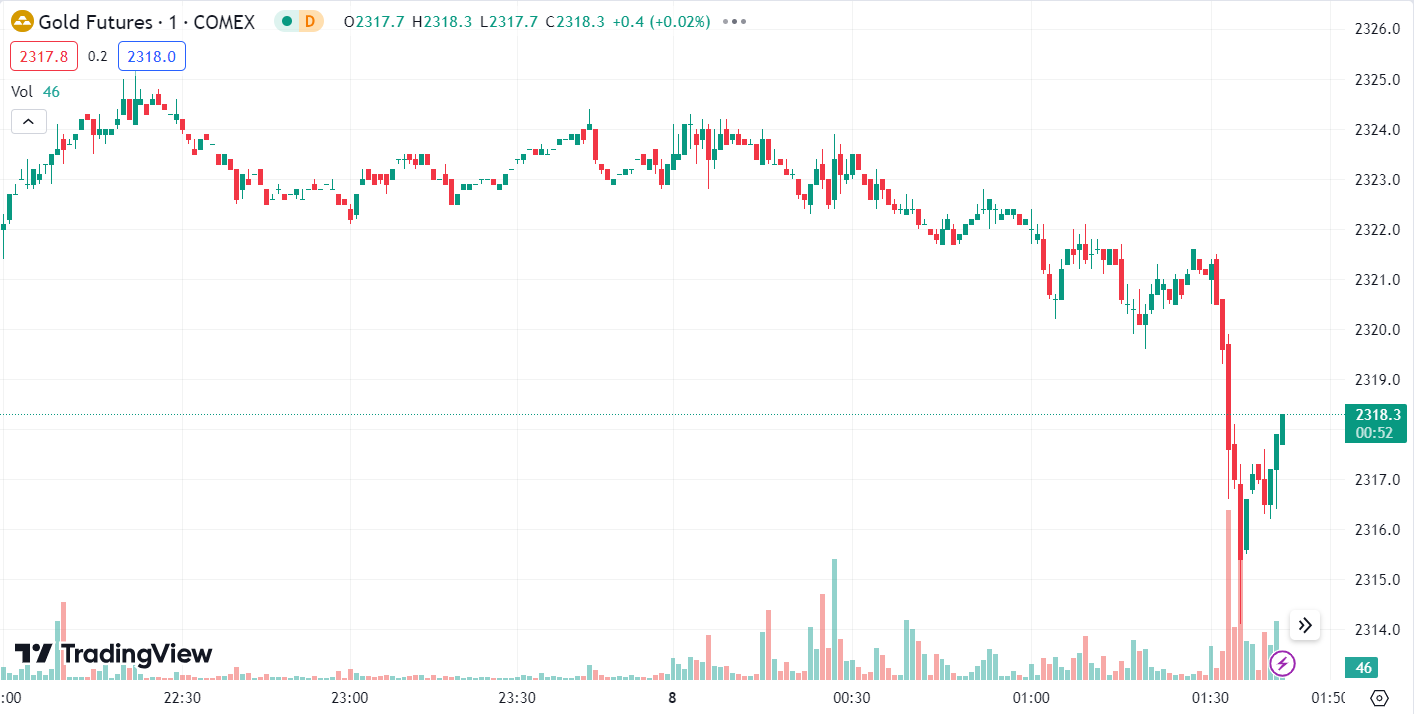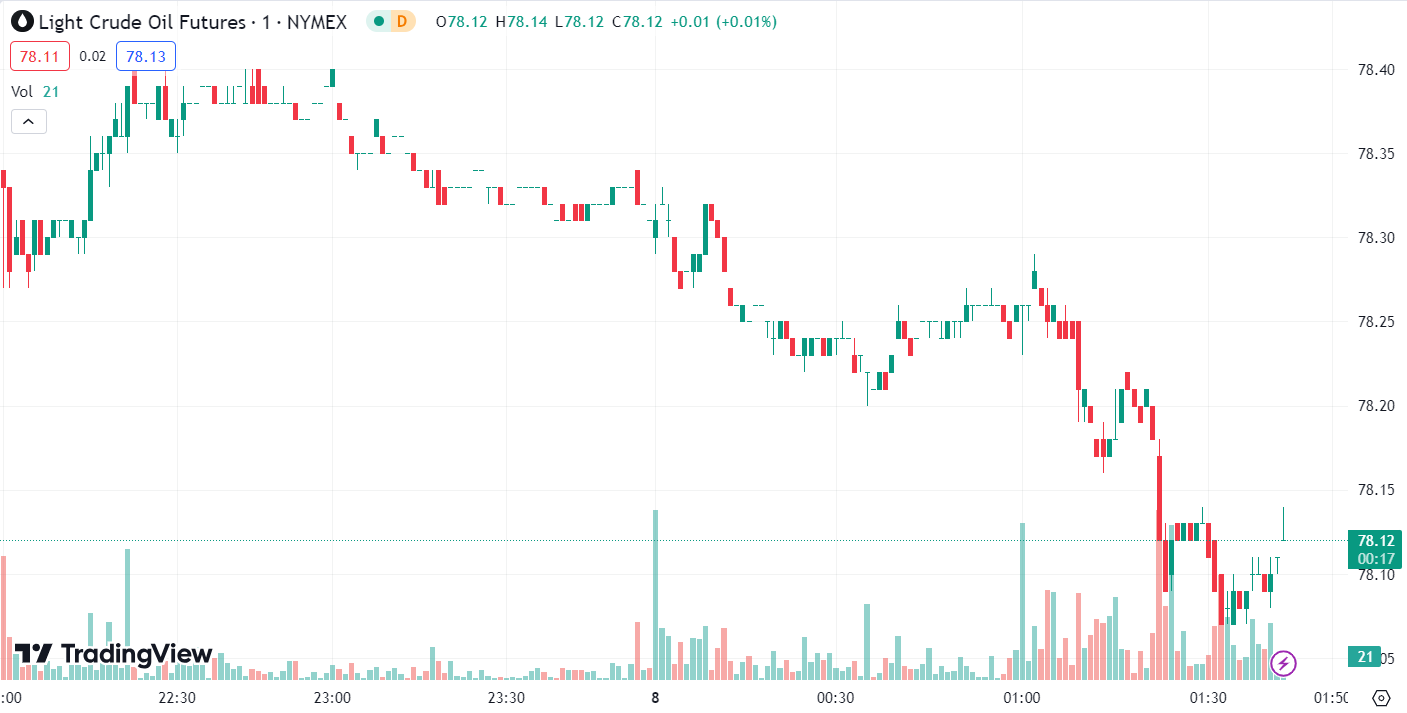
The US dollar index rose for the second consecutive trading day, causing a slight retreat in gold prices; signs indicate some relief in supply concerns, and the EIA monthly report also lowered demand growth expectations, leading to a slight decline in oil prices.
Gold >>
On Tuesday, Israeli forces seized the Rafah border crossing to block aid routes. Despite the belief in the US that they can break the ceasefire deadlock, safe-haven demand for gold was suppressed, leading to a rebound in the US dollar and a slight retreat in gold prices.
Spot gold breached the USD 2310 level briefly before closing down 0.43% at USD 2313.78 per ounce ahead of the US session. The Israeli military has begun evacuating civilians from Rafah. Ceasefire talks between Hamas and Israel held in Cairo over the weekend appear to have stalled, diminishing hopes for a Gaza ceasefire.
The ongoing tension in the Middle East seems to have bolstered bullish sentiment in gold. However, economists at Morgan Stanley currently predict three 25-basis-point rate cuts by the Federal Reserve this year, while futures traders anticipate two 25-basis-point cuts.
The US dollar index strengthened to 105.37, up about 0.27%, marking its second consecutive day of gains, exerting some pressure on gold prices. Yesterday, gold’s technical outlook saw narrow range-bound consolidation amid choppy trading.
During the Asian session, a slight rebound faced resistance at the USD 2329 level before quickly retreating. In the afternoon, it further dipped below the USD 2320 level to reach a narrow range of consolidation near USD 2312-15.
Ahead of the US session, it swiftly broke below the USD 2309 level before stabilizing and rebounding. After 23:00, it faced resistance around the USD 2323 level, leading to a retreat and closing with oscillations.
Technical Analysis:

Today’s short-term strategy for gold suggests prioritizing short positions during rebounds, with long positions considered as a secondary approach during pullbacks.
- Key resistance levels to watch in the short term are around 2330-2335.
- Key support levels to watch in the short term are around 2305-2300.
WTI Crude Oil >>
On Tuesday, there were indications that supply concerns eased slightly, and the EIA monthly report also revised down demand growth expectations. WTI crude oil briefly fell to an intraday low of USD 77.36 per barrel before partially recovering, ultimately closing down 0.41% at USD 78.11 per barrel.
Brent crude oil closed down 0.51% at USD 82.92 per barrel. The US Energy Information Administration (EIA) stated that global crude oil and liquid fuels production will increase by 970,000 barrels per day to reach 102.76 million barrels per day, compared to the previous forecast of an increase of 850,000 barrels per day.
It is projected that the growth rate of global oil demand this year will be lower than previously estimated, while production growth will be higher than previously expected, thereby bringing the market into a better balance.
Yesterday, oil prices saw a technical rebound amid choppy trading. After breaking below support, they quickly rebounded and rose. During the Asian and European sessions, prices fell and fluctuated around the USD 79 level before further declining below USD 78 to stabilize and rebound near USD 77.9.
In the late US session, there was a deep V-shaped rebound as prices stabilized around the USD 77.5 level, and they quickly rose above USD 79 to reach around USD 79.1 before closing with oscillations.
Technical Analysis:

Today’s crude oil trading strategy suggests prioritizing short positions during rebounds, with long positions considered as a secondary approach during pullbacks
- Key resistance levels to monitor in the short term are around 79.5-80.0.
- Key support levels to monitor in the short term are around 77.0-76.5.
Forward-looking Statements
This article contains “forward-looking statements” and may be identified by the use of forward-looking terminology such as “anticipate”, “believe”, “continue”, “could”, “estimate”, “expect”, “hope”, “intend”, “may”, “might”, “plan”, “potential”, “predict”, “should”, or “will”, or other variations thereon or comparable terminology. However, the absence of such terminology does not mean that a statement is not forward-looking. In particular, statements about the expectations, beliefs, plans, objectives, assumptions, future events, or future performance of Doo Prime will be generally assumed as forward-looking statements.
Doo Prime has provided these forward-looking statements based on all current information available to Doo Prime and Doo Prime’s current expectations, assumptions, estimates, and projections. While Doo Prime believes these expectations, assumptions, estimations, and projections are reasonable, these forward-looking statements are only predictions and involve known and unknown risks and uncertainties, many of which are beyond Doo Prime’s control. Such risks and uncertainties may cause results, performance, or achievements materially different from those expressed or implied by the forward-looking statements.
Doo Prime does not provide any representation or warranty on the reliability, accuracy, or completeness of such statements. Doo Prime is not obliged to provide or release any updates or revisions to any forward-looking statements.
Disclaimer
While every effort has been made to ensure the accuracy of the information in this document, DOO Prime does not warrant or guarantee the accuracy, completeness or reliability of this information. DOO Prime does not accept responsibility for any losses or damages arising directly or indirectly, from the use of this document. The material contained in this document is provided solely for general information and educational purposes and is not and should not be construed as, an offer to buy or sell, or as a solicitation of an offer to buy or sell, securities, futures, options, bonds or any other relevant financial instruments or investments. Nothing in this document should be taken as making any recommendations or providing any investment or other advice with respect to the purchase, sale or other disposition of financial instruments, any related products or any other products, securities or investments. Trading involves risk and you are advised to exercise caution in relation to the report. Before making any investment decision, prospective investors should seek advice from their own financial advisers, take into account their individual financial needs and circumstances and carefully consider the risks associated with such investment decision.